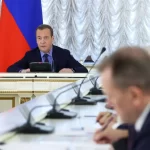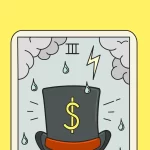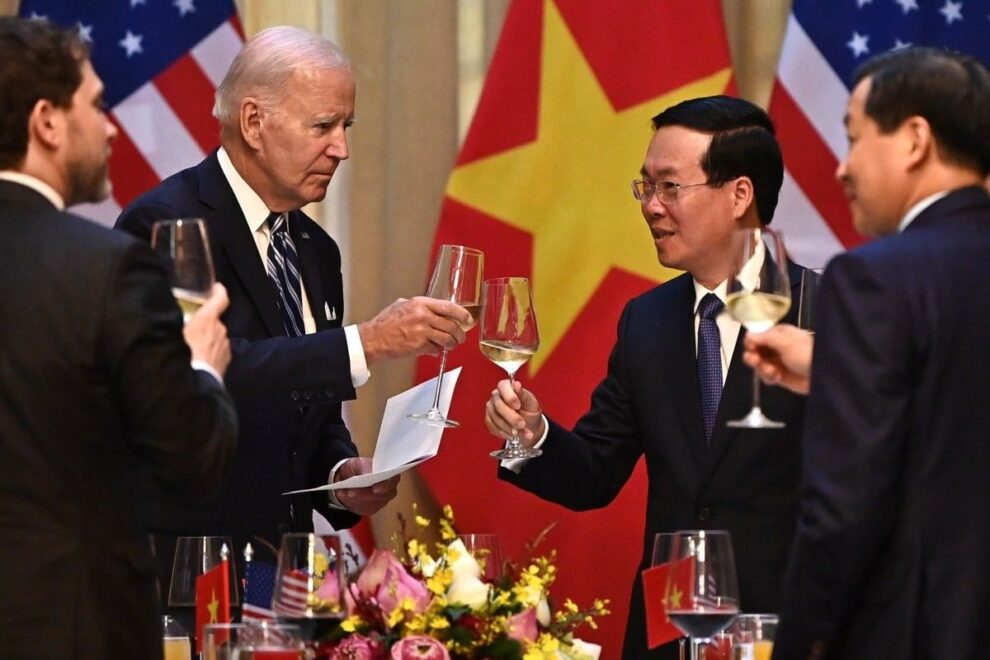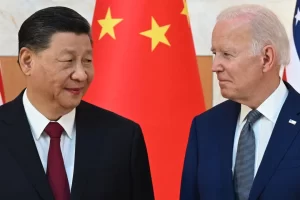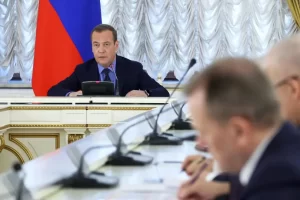KEEPING both the US and China onside is becoming increasingly difficult for Vietnam as it elevates ties with Washington and eyes US arms.
Vietnam has been making the most of the hardening geopolitical rivalry between its former mortal enemy and perennial northern neighbour.
The United States and China both hosted Prime Minister Pham Minh Chinh for high-level visits in recent weeks, as Vietnam has been profiting from increased trade with the world’s two largest economies – plus the spillover effects of their attempts to decouple.
Yet the Southeast Asian nation now risks being “caught in the crossfire” of intensifying US-China rivalry, analysts say, as despite “well-managed relations” that have allowed it to prosper and extract concessions from its top-two trading partners, its ever more precarious tightrope walk may eventually force it to pick sides.
Hanoi elevated its ties with Washington to what’s known as a comprehensive strategic partnership – the same level as its China relations – during a first-ever state visit to the country by US President Joe Biden last month. On a week-long return trip that also incorporated the 78th UN General Assembly in New York, Vietnam’s Chinh pushed for US Treasury Secretary Janet Yellen to support granting the communist country “market economy” status and help ease trade irritants such as anti-dumping duties.
But before leaving for the US, Chinh had first swung by the southern Chinese city of Nanning to attend the China-Asean Expo and meet Chinese Premier Li Qiang, where the two discussed the importance of prioritising neighbourhood diplomacy, expanding trade and accelerating cooperation on infrastructure and supply-chain connectivity, according to state media reports.
“It’s about maintaining Vietnam’s own strategic autonomy and independence, siding with the US where their interests happen to overlap, but not moving definitely into any ‘camp’,” said Greg Poling, director of the Washington-based Centre for Strategic and International Studies (CSIS) think tank’s Southeast Asia programme.
“Vietnam assesses that pulling the Americans closer economically and strategically is the best hedge against China,” which Hanoi views as a long-term strategic threat to be carefully managed, he said.
This approach could backfire, however, “as Hanoi doesn’t want to send the wrong signal to China,” said Nguyen Khac Giang, a researcher of Vietnamese politics at the ISEAS-Yusof Ishak Institute in Singapore.
A “high-profile” emphasis is needed to clarify to Beijing that Vietnam “does not want to take sides and is focusing primarily on economic cooperation”, he said – something Hanoi has largely succeeded in doing so far “due to its well-managed relations with both global powers”.
“However, as the great power rivalry intensifies, the risk of being caught in the crossfire is ever-present,” Giang warned.
 Biden (fourth from left) and Vietnam’s Communist Party General Secretary Nguyen Phu Trong (third from right) hold talks in Hanoi on September 10. – Photo: Kyodo via SCMP
Biden (fourth from left) and Vietnam’s Communist Party General Secretary Nguyen Phu Trong (third from right) hold talks in Hanoi on September 10. – Photo: Kyodo via SCMP
Alternative to China
Investors have increasingly turned to Vietnam as an alternative Asian base with fewer economic and political risks amid mounting US-China tensions.
During a visit to the country in July, Yellen described Vietnam as “a key partner” in the effort to reduce dependence on China by diversifying supply chains “to mitigate against global shocks, geopolitical risks and overconcentration in critical industries”.
“We see that in action right now,” she said. Two-way trade with the US hit US$139 billion last year – second only to the more than US$230 billion in trade Vietnam did with China in 2022 – while the US is now the Southeast Asian nation’s largest export market for textiles, footwear and electronics.
Chinese manufacturers have also come to see Vietnam as more of an investment destination in recent years, partly driven by the desire to avoid tariffs imposed since the outbreak of the US-China trade war in 2018.
Yet weaknesses in infrastructure, logistics, supporting industries, human resources and state capacity are all “factors that investors must consider” when looking to “Vietnam as an alternative to China”, said the ISEAS-Yusof Ishak Institute’s Giang.
Some analysts have suggested in the past that China-Vietnam ties are mostly underpinned by both being one-party communist states, but Giang said “the perception of national interests” plays “a more significant role in shaping the relationship than ideology”.
For Vietnam, these interests encompass the goal of becoming a modern industrial country prioritising semiconductors, electric-vehicle production and the green energy transition, as outlined during the Vietnamese Communist Party’s 13th National Congress in 2021.
Such “ambitious plans open up opportunities not only for trade and investment but human resources training and development” with both the US and China, said Carl Thayer, a Southeast Asia regional specialist and emeritus professor at The University of New South Wales.
The ultimate goal “if Vietnam is to have its cake and eat it too” was for Washington and Beijing to “find it in their interests to step up economic engagement,” he said.
Some of this engagement with China, such as the relocation of Chinese companies’ production processes to Vietnam, was designed to meet mutual interests, he said.
Thayer said Vietnam had been “the biggest winner” from US-China rivalry so far “because its primary driver was to secure increased economic cooperation in trade, investment, and technology transfer from the US and use this as leverage in securing more cooperation from China”.
He compared this to a previous Vietnamese policy of “cooperation and struggle” aimed at pursuing relations with China while putting constraints on its US ties to reinforce Hanoi’s “independence of action” and “strategic autonomy”.
Far from being opportunistic, Hanoi had conducted its great-power diplomacy with “meticulous planning”, Thayer said, citing the elevation of ties with the US by way of example.
 A worker checks printer circuit boards with a magnifying glass at a factory in Vietnam’s Bac Ninh province. The country has emerged as a destination for both US and Chinese investments. – Photo: Reuters
A worker checks printer circuit boards with a magnifying glass at a factory in Vietnam’s Bac Ninh province. The country has emerged as a destination for both US and Chinese investments. – Photo: Reuters
That process began with a phone call between Biden and Vietnam’s paramount leader Nguyen Phu Trong in March, after which Hanoi scoured the 2023 diplomatic calendar and had pinpointed a meeting with the US president on the sidelines of the G20 Summit in India, before this idea was itself sidelined after Biden agreed to visit, Thayer said.
“In sum, Vietnam is not explicitly pursuing a policy of hedging so much as consistent engagement with both China and the US,” he said.
For the time being, “Vietnam needs both the major powers, and the two powers also need Vietnam to maintain their security and economic well-being,” said Le Hong Hiep, coordinator of the ISEAS-Yusof Ishak Institute’s Vietnam studies programme, adding that Hanoi remained committed to an independent and balanced foreign policy that aims to maintain strong ties with both world powers.
“[But] as Sino-US strategic competition intensifies, it will become increasingly difficult for Vietnam to maintain such a balance.”
Maintaining a neutral foreign policy is vital if Hanoi is to avoid “being dragged into a US-China conflict, whether it is on the US or the Chinese side”, said Khang Vu, a PhD candidate majoring in international relations and East Asian security at Boston College in the US.
“Unfortunately, the more intense the US-China rivalry becomes, the less leeway Vietnam has to balance its relations between the US and China,” he said – pointing by way of historical example to how the Southeast Asian nation became an ideological battleground during the Sino-Soviet split of the 1960s.
US arms sales to Vietnam
Since upgrading their diplomatic ties, Washington and Hanoi have reportedly been in talks over the sale of a fleet of US F-16 fighter jets to Vietnam, which would constitute the largest-ever arms transfer between the former Cold War adversaries.
Exact terms of the deal, which may not come together, are still being worked out and sources who spoke to Reuters said Washington was considering structuring special financing terms for the pricey equipment that could help cash-strapped Hanoi steer away from its traditional reliance on lower-cost, Russian-made arms.
The ISEAS-Yusof Ishak Institute’s Giang said it was understandable that Vietnam would seek military procurement from the US now that they were comprehensive strategic partners, especially since Washington in 2016 had lifted an embargo on lethal weapons sales to Hanoi.
 US Air Force F-16 fighter jets fly over an airbase in South Korea. Washington is reportedly in talks to sell a fleet of the aircraft to Vietnam. – Photo: AP
US Air Force F-16 fighter jets fly over an airbase in South Korea. Washington is reportedly in talks to sell a fleet of the aircraft to Vietnam. – Photo: AP
“Whether these moves will undermine the bilateral relationship between Vietnam and China largely depends on how well Hanoi can convince Beijing – as well as how Beijing interprets these actions,” he said.
China’s nationalistic Global Times tabloid said the deal would only serve “the US’ hegemonic goals of containing China” and “stir up troubles that sabotage peace and stability in the region”, which “Vietnam will not easily accept”.
But Giang said “China will have no good reason to react negatively to such a deal” so long as “Vietnam maintains its ‘four no’s’”, referring to a policy of no military alliances, no siding with one country against another, no foreign military bases and no use or threat of force.
He added that if Vietnam does not end up buying fighter jets from the US, it was likely to get them from France, Israel or South Korea anyway, given that it was modernising its military.
“Whether Beijing takes hostile actions against Vietnam or not will depend on the nature and scale of the deal,” said ISEAS-Yusof Ishak Institute’s Le, noting that Hanoi acquiring F-16s would “understandably” cause some concern in Beijing.
“However, I think Chinese leaders appreciate the fact that Vietnam feels insecure due to the South China Sea disputes,” Le said, referring to Hanoi’s rejection of Beijing’s claims in the disputed waterway.
If concluded, Le said the F-16 deal would be of a limited scale and was unlikely to alter the balance of power between China and Vietnam, especially in the South China Sea.
“It is likely that China will tolerate Vietnam’s decision as long as Vietnam continues to maintain friendly ties with Beijing and refrain from taking serious anti-China measures,” he added.
As China’s military might dwarfs that of Vietnam, “what really matters is the political significance” of any arms sales and whether they indicate the abandonment of a neutral foreign policy and closer alignment with the US, Boston College’s Vu said.
Until recently, Vietnam had relied on Russia for around 70 per cent of its weaponry, spare parts and repairs to Soviet-era equipment, including an ageing fleet of fighter jets, tanks and warships – making it the biggest buyer of Russian arms in Southeast Asia.
But since its invasion of Ukraine in February last year, Moscow has had to retain more munitions for its own use, while Western-led sanctions have threatened any defence deals made with Russia.
CSIS’ Poling said Vietnam was now committed to diversifying its military kit away from Russia, which it “increasingly views as a strategic liability, over the years to come” and this “will doubtless involve purchases from the US as well as other partners in Europe, [South] Korea, and so on”.
Earlier this year, Vietnam was said to be in talks with the Czech Republic – a former Soviet satellite state whose military firms excel at retrofitting Russian gear and often manufacture new equipment that is compatible with Soviet legacy arms – for aircraft, radars, upgrades of armoured vehicles, firearms and other supplies.
There’s precedent for defence deals with the US, too.
In 2021, the US Air Force agreed to supply Vietnam with 12 T-6 trainer aircraft and a 10-year maintenance package costing at least US$225 million, with delivery expected between next year and 2027.
Training for Vietnamese pilots is included under the terms of the deal – in simulators and with US experts on night and bad-weather flying.
The eventual aim, Thayer said, was to invite Vietnam’s air force to take part in Exercise Red Flag, two week of advanced aerial combat training drills held several times a year by the US Air Force, to “provide training and experience in humanitarian assistance, disaster relief, search and rescue, and command and control missions.” – South China Morning Post
Source : The Star



